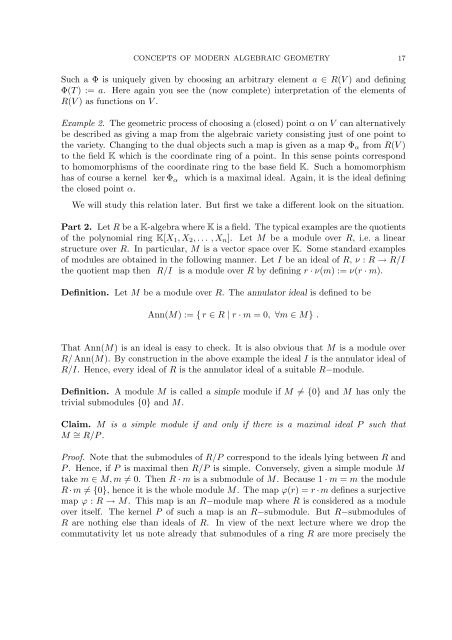Mannheimer Manuskripte 177 gk-mp-9403/3 SOME CONCEPTS OF ...
Mannheimer Manuskripte 177 gk-mp-9403/3 SOME CONCEPTS OF ...
Mannheimer Manuskripte 177 gk-mp-9403/3 SOME CONCEPTS OF ...
- No tags were found...
Create successful ePaper yourself
Turn your PDF publications into a flip-book with our unique Google optimized e-Paper software.
<strong>CONCEPTS</strong> <strong>OF</strong> MODERN ALGEBRAIC GEOMETRY 17Such a Φ is uniquely given by choosing an arbitrary element a ∈ R(V ) and definingΦ(T) := a. Here again you see the (now co<strong>mp</strong>lete) interpretation of the elements ofR(V ) as functions on V .Exa<strong>mp</strong>le 2. The geometric process of choosing a (closed) point α on V can alternativelybe described as giving a map from the algebraic variety consisting just of one point tothe variety. Changing to the dual objects such a map is given as a map Φ α from R(V )to the field K which is the coordinate ring of a point. In this sense points correspondto homomorphisms of the coordinate ring to the base field K. Such a homomorphismhas of course a kernel ker Φ α which is a maximal ideal. Again, it is the ideal definingthe closed point α.We will study this relation later. But first we take a different look on the situation.Part 2. Let R be a K-algebra where K is a field. The typical exa<strong>mp</strong>les are the quotientsof the polynomial ring K[X 1 ,X 2 ,... ,X n ]. Let M be a module over R, i.e. a linearstructure over R. In particular, M is a vector space over K. Some standard exa<strong>mp</strong>lesof modules are obtained in the following manner. Let I be an ideal of R, ν : R → R/Ithe quotient map then R/I is a module over R by defining r · ν(m) := ν(r · m).Definition. Let M be a module over R. The annulator ideal is defined to beAnn(M) := {r ∈ R | r · m = 0, ∀m ∈ M} .That Ann(M) is an ideal is easy to check. It is also obvious that M is a module overR/Ann(M). By construction in the above exa<strong>mp</strong>le the ideal I is the annulator ideal ofR/I. Hence, every ideal of R is the annulator ideal of a suitable R−module.Definition. A module M is called a si<strong>mp</strong>le module if M ≠ {0} and M has only thetrivial submodules {0} and M.Claim. M is a si<strong>mp</strong>le module if and only if there is a maximal ideal P such thatM ∼ = R/P.Proof. Note that the submodules of R/P correspond to the ideals lying between R andP. Hence, if P is maximal then R/P is si<strong>mp</strong>le. Conversely, given a si<strong>mp</strong>le module Mtake m ∈ M,m ≠ 0. Then R · m is a submodule of M. Because 1 · m = m the moduleR ·m ≠ {0}, hence it is the whole module M. The map ϕ(r) = r ·m defines a surjectivemap ϕ : R → M. This map is an R−module map where R is considered as a moduleover itself. The kernel P of such a map is an R−submodule. But R−submodules ofR are nothing else than ideals of R. In view of the next lecture where we drop thecommutativity let us note already that submodules of a ring R are more precisely the
















